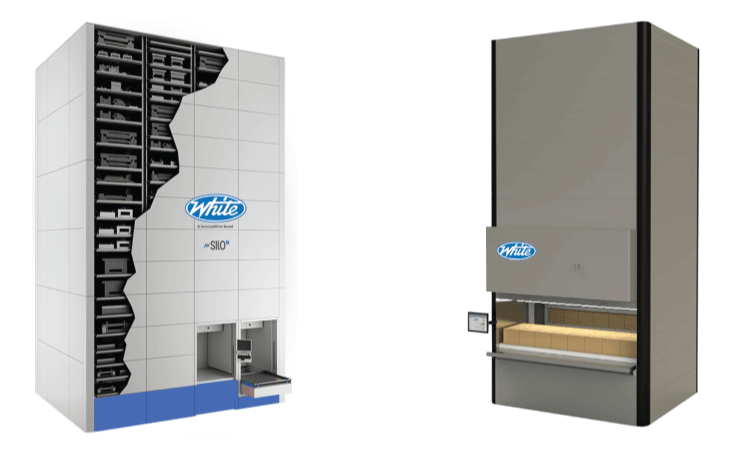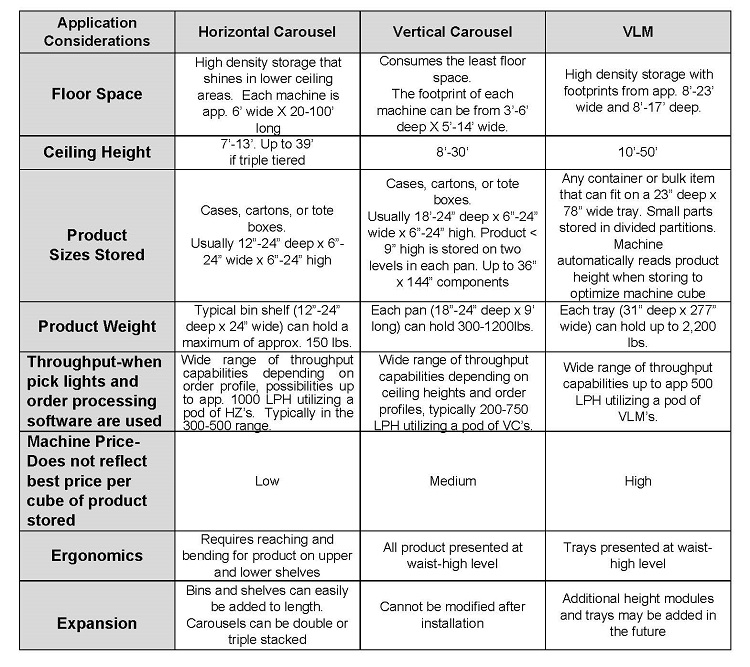The Difference Between Vertical Carousels, Horizontal Carousels, and Vertical Lift Module (VLM) Solutions
Space utilization efficiencies, and choosing the right solution.
Intelligent storage solutions help companies increase productivity, enhance efficiencies, and use space more effectively. To help determine if your company will benefit from an intelligent storage solution, it is important to identify the system that has the features that best align with your company needs and requirements.

Vertical Carousels
Vertical carousels use automation to direct a pathway of standard shelves inside a single storage unit. The shelves are linked with a chain that rotates within the structure vertically, like the mechanism that drives a Ferris wheel.
Shelves suspend vertically and move via software or operator control. Carousels are automated to bring the proper shelf to the operator from the closest direction.
Vertical carousels are ideal for the storage of items in totes or items of similar heights. Vertical carousels have the smallest footprint and the highest speed compared to other vertical storage units.
Horizontal Carousel
Horizontal carousels operate similarly to vertical carousels since both machines have shelving placed close together and linked with chains. As the name implies, however, horizontal carousels operate horizontally, parallel to the warehouse floor.
To concentrate storage even more, two or three machines can be stacked. Further, multiple horizontal carousels can be located adjacent to one another so that they can deliver items at a single point, increasing operator productivity.
The operator can pick from one horizontal carousel while adjacent carousels are positioning and preparing the operator for the next process. The ability to use multiple carousels together allows for large storage capacity with high pick rates.
Vertical Lift Modules
Vertical lift modules (VLMs) have shelving units mounted inside the front and rear with a picking elevator operating centrally. The elevator moves vertically in between the stacks to select shelves as directed by an operator or software.
VLMs deliver the shelf at an access point, which is about waist high for an operator in front of the machine. VLMs are ideal for the storage of products that vary in height, and they can be single or multi-column. Multi-column designs are useful with large storage and high pick-rate requirements
How to Choose the Intelligent Storage Solution that Best Meets Your Needs
The easiest way to determine whether you need vertical carousels, horizontal carousels, or vertical lift modules (VLM) is to ask yourself, “What storage and retrieval issues are we trying to solve? Is our biggest concern storage density, throughput, increased pick-rate, or some other storage and retrieval matter?
Throughput and Capacity
When choosing an intelligent storage solution, it is important to consider the speed and demand of the picking unit, known as throughput.
To determine throughput, you need to know not only average speed requirements but also peak demand requirements. Pick rates can further be enhanced through the use of storage slotting with item affinity and batch picking.
Product Size and Square Footage
The next questions to answer are: What are the square and cubic footage capacity of your warehouse? Do you have the need to store products vertically, achieve a higher velocity in picking, or even a combination of the two?
When reviewing product size, determine the height and length of each product as well as the variation of product sizes. A slotting analysis can help optimize storage placement because it takes into account various sizes to help identify which intelligent storage solution will best fit the requirements.
Comparison of Intelligent Storage Solution Requirements and Features

